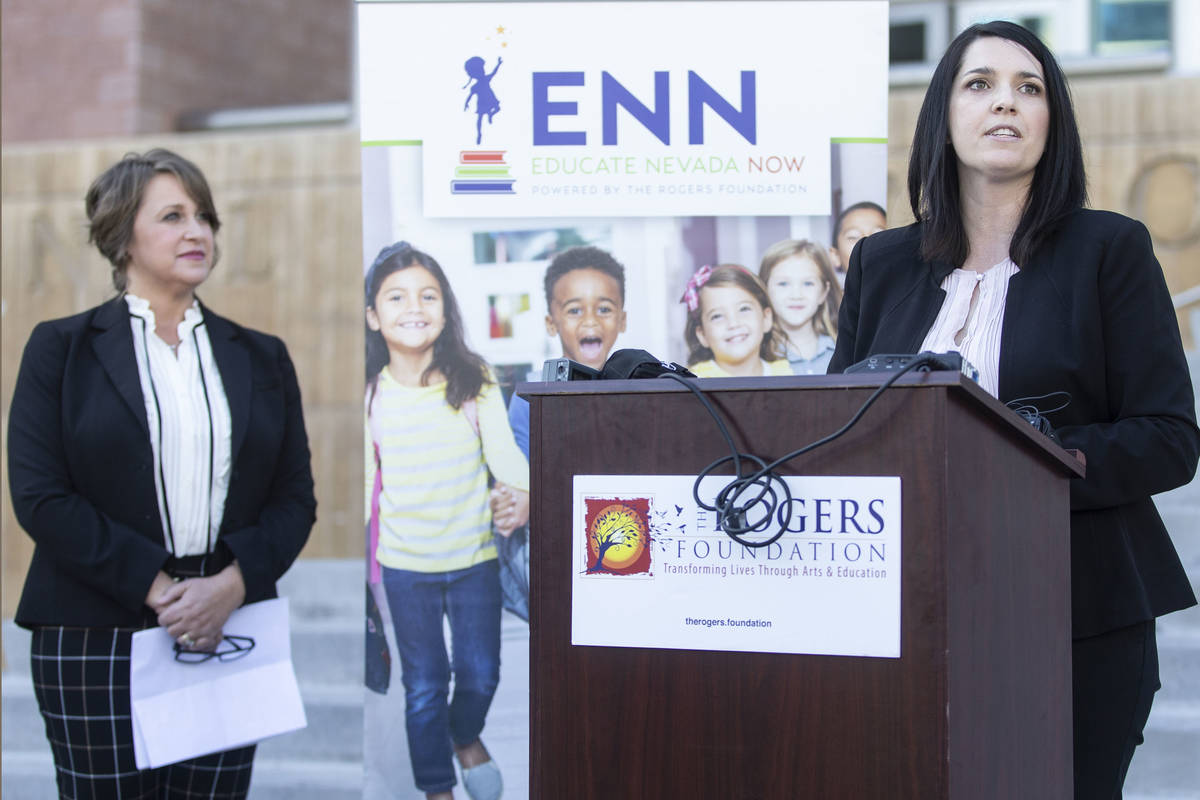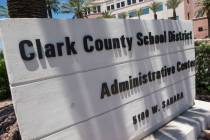Nevada commission to explore goals for optimal education funding
On the anniversary of its first meeting last year, the Nevada Commission on School Funding will delve into the central question it was tasked with solving: How much should the state spend on each of its K-12 students, and where could that money come from?
The commission charged with studying and making recommendations on the new Nevada school funding formula approved by the Legislature in 2019 has spent its first year discussing the nuts and bolts of the new financial structure and how the mandated weights — categorical funding for certain student groups — will be determined.
Beginning Friday, the group’s next task is to define the amorphous concept of optimal funding for education outlined by Senate Bill 543, including recommendations on what the Legislature could do to get there over time, even as the state reels from the economic downturn caused by the COVID-19 pandemic.
“Is it the best of times?” said commission Chairwoman Karlene McCormick-Lee. “The best of times would be when occupancy in every hotel is at 100 percent, there’s an influx of people coming in, millions of tourists, and someone at a mining group hit a mother lode of titanium. … Then when we say optimal funding is going to require more money, it’s easy. But do you wait till that day to say that children who face challenges need support? I think you tackle that every day. I don’t think you can wait two years to do that.”
The work so far
To get a sense of the commission’s work to date, picture the process of moving into a new house. First, you identify what you’re taking with you and pack it up; that’s the 80 or so revenue streams that made up the old Nevada Plan. Then you load it on a truck and get it to the new house, unpack it and see where it goes; that’s putting the money in a single pot and then figuring out how much goes to each student.
Like moving, the new formula can be an uncomfortable transition, said McCormick-Lee, a former Clark County School District administrator, UNLV visiting scholar and educational consultant who’s worked across the country. But once it’s settled, it will better suit the state’s needs.
The goal is to make student funding transparent and easy to understand, McCormick-Lee said: Student A gets X amount of dollars in base funding, plus one categorical weight they might qualify for and an adjustment based on the school district he or she attends.
The lack of transparency of the old formula made it challenging to explain how the state was underfunding students, said commission member Jim McIntosh, former CCSD chief financial officer and now CFO for the city of Henderson.
In addition to more transparency, one of the most encouraging recommendations from the commission so far has been the recognition that the state needs a new way to define at-risk students, he said.
The traditional metric has been the number of students who qualify for free and reduced-price lunch — which at the district is two-thirds of all students — but the student information portal Infinite Campus could offer dozens of other indicators like academic performance to better target where the dollars for at-risk students go, McCormick-Lee said.
The commission has yet to settle on a definition, but has recommended that the State Board of Education prescribe a new metric for these students.
Optimal vs. adequate
Amanda Morgan, legal director of Educate Nevada Now, characterized the recommendations so far as largely technical, predicated on the idea that it’s important to nail down the mechanics of the formula before getting into the question of funding.
But on the flip side, she said, it’s nearly impossible to determine what a student should get in weighted funds without discussing first how much money is needed to meet the provisions of Senate Bill 543, including optimal funding.
Beginning this week, Morgan said the commission will have the chance to not only establish a goal for how much the state should spend on students in 10 years, but also set benchmarks for the next few sessions of the Legislature and identify potential funding sources. Tapping into property taxes has already been suggested.
This 10-year target is why other states have been successful in revamping their school funding and Nevada has not, Morgan said.
“There has been a lot of supplanting,” she said. “With targets, you can’t fake that: Are we getting closer to that target or are we not?”
But what does optimal funding mean? Does optimal mean parity across other states or does it mean funding to ensure that all students have an opportunity to be successful? McCormick-Lee said. Whatever the definition, it has to mean more than just meeting federal requirements, she added.
John Vellardita, executive director of the Clark County Education Association, said: “Optimal means best. But is it the best of what we can afford, or in terms of what the levels should be?”
Vellardita said the teachers union has been and continues to be supportive of the commission’s work. In addition to the 10-year plan, his members would like to see what it would take to bring Nevada up to target levels immediately.
The union is behind a pair of petitions to increase sales and gaming taxes in order to raise over $1 billion for education. While they are still awaiting ballot certification, Vellardita said, the initiatives could be available for legislators to consider next year. If they’re not taken up, he said, he hopes they force a discussion of an alternative.
“There’s an acknowledgment on the part of lawmakers that they can’t go into the session again without looking at revenue,” Vellardita said. “There’s going to be an effort that we’re going to lead that you have to diversify the economy.”
The case for delaying
The formula is set to take effect in 2022, but not everyone is keen on implementing it then — particularly not during the economic downturn caused by the COVID-19 pandemic. The chief concern plaguing the law is that it didn’t provide any additional funds, but instead spread existing funds over a larger group of students — like moving into a new house and having to share all your stuff with your neighbors.
Advocates for Zoom and Victory schools, which serve English-learner and impoverished students and whose funds would be added to the pot to reach more students via weights, say they’re hesitant to relinquish those extra funds without a guarantee that they’ll be replaced.
“When you invest in high-poverty schools, it’s really hard to find programs that work. Because of the sustained effort, (Zoom and Victory) have worked,” said Sylvia Lazos, a UNLV professor and an education advocate.
This summer’s special session of the Legislature also added to those concerns as the Legislature voted to cut funds for Senate Bill 178, which offered weighted funding for English-learner or impoverished students who didn’t attend Zoom or Victory schools.
Brian Rippet of the Nevada State Education Association said the organization has been concerned with the funding formula since the start because of the effect it will have on schools in rural counties, effectively freezing them at their current funding levels until they’re on par with other districts.
The pandemic and the ensuing cuts to education have added to those concerns, Rippet said, with less money available after the SB 178 cuts to devote to weighted funding.
“They say there’s no impact to their work via COVID, but in reality the budget crashed,” Rippet said. “There could be, absent change or interventions, some big cuts to be made.”
Will this time be different?
In interviews, commission members and advocates described a sense of deja vu when it comes to school funding in Nevada, which studies have found to be about $3,000 short per student. But those studies have been commissioned, presented and filed away without action, and SB 543 doesn’t bind the state to following the recommendations on optimal funding set by this commission either.
Member Paul Johnson, chief financial officer of the White Pine County School District, said this commission is his third time sitting on a formula evaluation committee. In 2006, a similar body was charged with studying the Nevada Plan on the heels of an adequacy study, he said, but its work was cut short when the recession hit.
As the state now takes that familiar path, Johnson said he’s hopeful for a number of reasons, not least of which is that this commission is studying an entirely new formula, rather than the old one.
“The current formula was never designed to fund program weights, like English Language Learners,” he said. “We were trying to make the Nevada Plan do something it was never designed to do.”
Caryne Shea of HOPE for Nevada said previous recommendations on funding have always been on target but never heeded. While there have been legitimate concerns about the formula, she said commissioners have ultimately done a thoughtful job and that she wouldn’t support a delay.
“Implementing it may actually force legislators to see how grossly underfunded we are,” she said.
On how to hold state leaders to the tenets of SB 543, Morgan of Educate Nevada Now added: “Don’t underestimate the power of public embarrassment.”
Contact Aleksandra Appleton at 702-383-0218 or aappleton @reviewjournal.com. Follow @aleksappleton on Twitter.






























